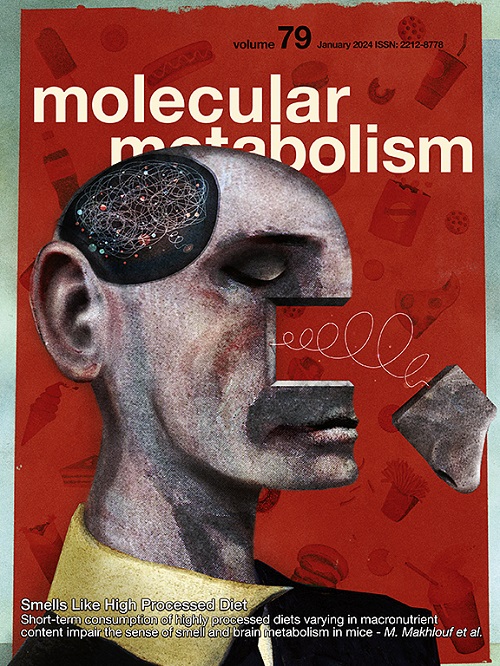An epigenome atlas of mouse adipocytes
IF 6.6
2区 医学
Q1 ENDOCRINOLOGY & METABOLISM
引用次数: 0
Abstract
Objective
Epigenetic modifications including histone post translational modifications can influence gene expression in adipocytes, potentially contributing to metabolic dysfunctions, obesity, and insulin resistance. Despite recent advances in the characterization of the mouse adipocyte epigenome, epigenetic characterization of adipocytes in vivo has been challenging, particularly across different adipose depots and of several epigenetic modifications.
Methods
Here, we use specific reporter mice labelling brown, beige and white adipocytes, diphtheria toxin-mediated ablation of beige adipocytes, and Cleavage Under Targets and Tagmentation (CUT&Tag) to generate paired single mouse datasets of five histone marks. We perform an integrative multi-omics factor analysis (MOFA) of H3K4me3, H3K27me3, H3K4me1, H3K27ac and H3K9me3 in brown, white and beige adipocytes from three distinct mouse adipose tissue depots obtained during cold exposure and thermoneutrality.
Results
Our analysis reveals that enhancers distinguish adipocytes by their tissue of origin, with H3K4me1 deposition differentiating between beige and brown adipocytes. Beige adipocytes poised promoters associated to thermogenic genes during warming. Diphtheria toxin-mediated ablation of beige adipocytes shows that non-beigeing white adipocytes in inguinal adipose tissue and beige adipocytes are not inherently epigenetically different suggesting that they share a common developmental progenitor.
Conclusions
These paired multimodal data comprise an extensive resource (https://github.com/vonMeyennLab/mAT_CE_Atlas) for the further exploration of the mouse adipocyte epigenome which will enable discovery of regulatory elements governing adipocyte identity and gene regulation.
小鼠脂肪细胞表观基因组图谱。
目的:包括组蛋白翻译后修饰在内的表观遗传修饰可以影响脂肪细胞中的基因表达,可能导致代谢功能障碍、肥胖和胰岛素抵抗。尽管最近在小鼠脂肪细胞表观基因组表征方面取得了进展,但体内脂肪细胞的表观遗传表征一直具有挑战性,特别是在不同的脂肪储存和几种表观遗传修饰之间。方法:在这里,我们使用特异性报告小鼠标记棕色、米色和白色脂肪细胞,白喉毒素介导的米色脂肪细胞的消蚀,以及切割靶蛋白和标记(CUT&Tag)来生成五个组蛋白标记的配对单小鼠数据集。我们对在冷暴露和热中性过程中获得的三种不同的小鼠脂肪组织库中的棕色、白色和米色脂肪细胞中的H3K4me3、H3K27me3、H3K4me1、H3K27ac和H3K9me3进行了综合多组学因子分析(MOFA)。结果:我们的分析显示,增强子通过其来源组织来区分脂肪细胞,H3K4me1沉积可以区分米色和棕色脂肪细胞。在升温过程中,米色脂肪细胞平衡了与产热基因相关的启动子。白喉毒素介导的米色脂肪细胞消融表明,腹股沟脂肪组织中的非米色白色脂肪细胞和米色脂肪细胞在表观遗传上没有内在的差异,这表明它们具有共同的发育祖细胞。结论:这些配对的多模态数据为进一步探索小鼠脂肪细胞表观基因组提供了广泛的资源(https://nme.ethz.ch/mAT_CEAtlas.html),这将有助于发现控制脂肪细胞身份和基因调控的调控元件。
本文章由计算机程序翻译,如有差异,请以英文原文为准。
求助全文
约1分钟内获得全文
求助全文
来源期刊

Molecular Metabolism
ENDOCRINOLOGY & METABOLISM-
CiteScore
14.50
自引率
2.50%
发文量
219
审稿时长
43 days
期刊介绍:
Molecular Metabolism is a leading journal dedicated to sharing groundbreaking discoveries in the field of energy homeostasis and the underlying factors of metabolic disorders. These disorders include obesity, diabetes, cardiovascular disease, and cancer. Our journal focuses on publishing research driven by hypotheses and conducted to the highest standards, aiming to provide a mechanistic understanding of energy homeostasis-related behavior, physiology, and dysfunction.
We promote interdisciplinary science, covering a broad range of approaches from molecules to humans throughout the lifespan. Our goal is to contribute to transformative research in metabolism, which has the potential to revolutionize the field. By enabling progress in the prognosis, prevention, and ultimately the cure of metabolic disorders and their long-term complications, our journal seeks to better the future of health and well-being.
 求助内容:
求助内容: 应助结果提醒方式:
应助结果提醒方式:


